Specific graphs
The thickness of the complete graph on n vertices, Kn, is
except when n = 9, 10 for which the thickness is three. [6] [7]
With some exceptions, the thickness of a complete bipartite graph Ka,b is generally: [8] [9]
In graph theory, the thickness of a graph G is the minimum number of planar graphs into which the edges of G can be partitioned. That is, if there exists a collection of k planar graphs, all having the same set of vertices, such that the union of these planar graphs is G, then the thickness of G is at most k. [1] [2] In other words, the thickness of a graph is the minimum number of planar subgraphs whose union equals to graph G. [3]
Thus, a planar graph has thickness 1. Graphs of thickness 2 are called biplanar graphs. The concept of thickness originates in the Earth–Moon problem on the chromatic number of biplanar graphs, posed in 1959 by Gerhard Ringel, [4] and on a related 1962 conjecture of Frank Harary: For any graph on 9 points, either itself or its complementary graph is non-planar. The problem is equivalent to determining whether the complete graph K9 is biplanar (it is not, and the conjecture is true). [5] A comprehensive [3] survey on the state of the arts of the topic as of 1998 was written by Petra Mutzel, Thomas Odenthal and Mark Scharbrodt. [2]
The thickness of the complete graph on n vertices, Kn, is
except when n = 9, 10 for which the thickness is three. [6] [7]
With some exceptions, the thickness of a complete bipartite graph Ka,b is generally: [8] [9]
Every forest is planar, and every planar graph can be partitioned into at most three forests. Therefore, the thickness of any graph G is at most equal to the arboricity of the same graph (the minimum number of forests into which it can be partitioned) and at least equal to the arboricity divided by three. [2] [10]
The graphs of maximum degree have thickness at most . [11] This cannot be improved: for a -regular graph with girth at least , the high girth forces any planar subgraph to be sparse, causing its thickness to be exactly . [12]

Graphs of thickness with vertices have at most edges. Because this gives them average degree less than , their degeneracy is at most and their chromatic number is at most . Here, the degeneracy can be defined as the maximum, over subgraphs of the given graph, of the minimum degree within the subgraph. In the other direction, if a graph has degeneracy then its arboricity and thickness are at most . One can find an ordering of the vertices of the graph in which each vertex has at most neighbors that come later than it in the ordering, and assigning these edges to distinct subgraphs produces a partition of the graph into trees, which are planar graphs.
Even in the case , the precise value of the chromatic number is unknown; this is Gerhard Ringel's Earth–Moon problem. An example of Thom Sulanke shows that, for , at least 9 colors are needed. [13]
Thickness is closely related to the problem of simultaneous embedding. [14] If two or more planar graphs all share the same vertex set, then it is possible to embed all these graphs in the plane, with the edges drawn as curves, so that each vertex has the same position in all the different drawings. However, it may not be possible to construct such a drawing while keeping the edges drawn as straight line segments.
A different graph invariant, the rectilinear thickness or geometric thickness of a graph G, counts the smallest number of planar graphs into which G can be decomposed subject to the restriction that all of these graphs can be drawn simultaneously with straight edges. The book thickness adds an additional restriction, that all of the vertices be drawn in convex position, forming a circular layout of the graph. However, in contrast to the situation for arboricity and degeneracy, no two of these three thickness parameters are always within a constant factor of each other. [15]
It is NP-hard to compute the thickness of a given graph, and NP-complete to test whether the thickness is at most two. [16] However, the connection to arboricity allows the thickness to be approximated to within an approximation ratio of 3 in polynomial time.
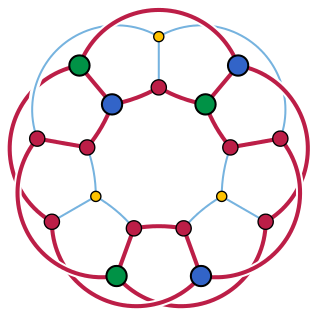
In graph theory, Kuratowski's theorem is a mathematical forbidden graph characterization of planar graphs, named after Kazimierz Kuratowski. It states that a finite graph is planar if and only if it does not contain a subgraph that is a subdivision of or of .
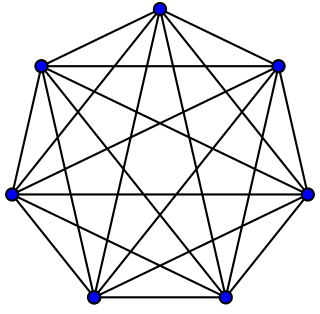
In the mathematical field of graph theory, a complete graph is a simple undirected graph in which every pair of distinct vertices is connected by a unique edge. A complete digraph is a directed graph in which every pair of distinct vertices is connected by a pair of unique edges.
Informally, the reconstruction conjecture in graph theory says that graphs are determined uniquely by their subgraphs. It is due to Kelly and Ulam.
In graph theory, an undirected graph H is called a minor of the graph G if H can be formed from G by deleting edges, vertices and by contracting edges.

In the mathematical area of graph theory, a clique is a subset of vertices of an undirected graph such that every two distinct vertices in the clique are adjacent. That is, a clique of a graph is an induced subgraph of that is complete. Cliques are one of the basic concepts of graph theory and are used in many other mathematical problems and constructions on graphs. Cliques have also been studied in computer science: the task of finding whether there is a clique of a given size in a graph is NP-complete, but despite this hardness result, many algorithms for finding cliques have been studied.

In graph theory, a proper edge coloring of a graph is an assignment of "colors" to the edges of the graph so that no two incident edges have the same color. For example, the figure to the right shows an edge coloring of a graph by the colors red, blue, and green. Edge colorings are one of several different types of graph coloring. The edge-coloring problem asks whether it is possible to color the edges of a given graph using at most k different colors, for a given value of k, or with the fewest possible colors. The minimum required number of colors for the edges of a given graph is called the chromatic index of the graph. For example, the edges of the graph in the illustration can be colored by three colors but cannot be colored by two colors, so the graph shown has chromatic index three.

In graph theory, the Hadwiger number of an undirected graph G is the size of the largest complete graph that can be obtained by contracting edges of G. Equivalently, the Hadwiger number h(G) is the largest number n for which the complete graph Kn is a minor of G, a smaller graph obtained from G by edge contractions and vertex and edge deletions. The Hadwiger number is also known as the contraction clique number of G or the homomorphism degree of G. It is named after Hugo Hadwiger, who introduced it in 1943 in conjunction with the Hadwiger conjecture, which states that the Hadwiger number is always at least as large as the chromatic number of G.
The arboricity of an undirected graph is the minimum number of forests into which its edges can be partitioned. Equivalently it is the minimum number of spanning forests needed to cover all the edges of the graph. The Nash-Williams theorem provides necessary and sufficient conditions for when a graph is k-arboric.
In mathematics, a dense graph is a graph in which the number of edges is close to the maximal number of edges. The opposite, a graph with only a few edges, is a sparse graph. The distinction of what constitutes a dense or sparse graph is ill-defined, and is often represented by 'roughly equal to' statements. Due to this, the way that density is defined often depends on the context of the problem.

In graph theory, a book embedding is a generalization of planar embedding of a graph to embeddings in a book, a collection of half-planes all having the same line as their boundary. Usually, the vertices of the graph are required to lie on this boundary line, called the spine, and the edges are required to stay within a single half-plane. The book thickness of a graph is the smallest possible number of half-planes for any book embedding of the graph. Book thickness is also called pagenumber, stacknumber or fixed outerthickness. Book embeddings have also been used to define several other graph invariants including the pagewidth and book crossing number.
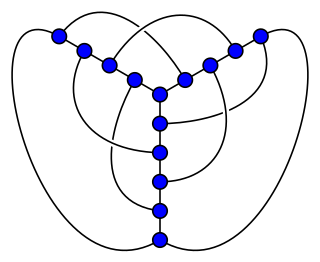
In graph theory, the crossing numbercr(G) of a graph G is the lowest number of edge crossings of a plane drawing of the graph G. For instance, a graph is planar if and only if its crossing number is zero. Determining the crossing number continues to be of great importance in graph drawing, as user studies have shown that drawing graphs with few crossings makes it easier for people to understand the drawing.
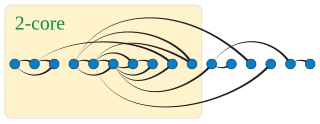
In graph theory, a k-degenerate graph is an undirected graph in which every subgraph has a vertex of degree at most k: that is, some vertex in the subgraph touches k or fewer of the subgraph's edges. The degeneracy of a graph is the smallest value of k for which it is k-degenerate. The degeneracy of a graph is a measure of how sparse it is, and is within a constant factor of other sparsity measures such as the arboricity of a graph.

Sumner's conjecture states that every orientation of every -vertex tree is a subgraph of every -vertex tournament. David Sumner, a graph theorist at the University of South Carolina, conjectured in 1971 that tournaments are universal graphs for polytrees. The conjecture was proven for all large by Daniela Kühn, Richard Mycroft, and Deryk Osthus.

In graph theory and computer science, a dense subgraph is a subgraph with many edges per vertex. This is formalized as follows: let G = (V, E) be an undirected graph and let S = (VS, ES) be a subgraph of G. Then the density of S is defined to be:
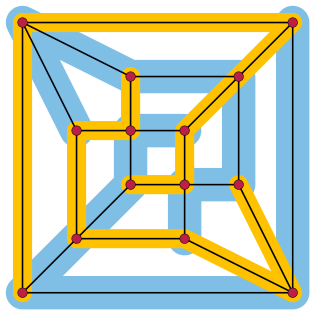
In graph theory, a branch of mathematics, the linear arboricity of an undirected graph is the smallest number of linear forests its edges can be partitioned into. Here, a linear forest is an acyclic graph with maximum degree two; that is, it is a disjoint union of path graphs. Linear arboricity is a variant of arboricity, the minimum number of forests into which the edges can be partitioned.

In graph drawing and geometric graph theory, the slope number of a graph is the minimum possible number of distinct slopes of edges in a drawing of the graph in which vertices are represented as points in the Euclidean plane and edges are represented as line segments that do not pass through any non-incident vertex.
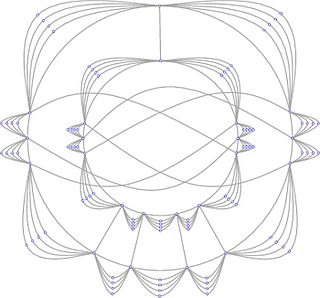
In mathematics, a topological graph is a representation of a graph in the plane, where the vertices of the graph are represented by distinct points and the edges by Jordan arcs joining the corresponding pairs of points. The points representing the vertices of a graph and the arcs representing its edges are called the vertices and the edges of the topological graph. It is usually assumed that any two edges of a topological graph cross a finite number of times, no edge passes through a vertex different from its endpoints, and no two edges touch each other. A topological graph is also called a drawing of a graph.

In the mathematical field of graph theory, the queue number of a graph is a graph invariant defined analogously to stack number using first-in first-out (queue) orderings in place of last-in first-out (stack) orderings.
In graph theory, the Nash-Williams theorem is a tree-packing theorem that describes how many edge-disjoint spanning trees (and more generally forests) a graph can have:
A graph G has t edge-disjoint spanning trees iff for every partition where there are at least t(k − 1) crossing edges (Tutte 1961, Nash-Williams 1961).
The Earth–Moon problem is an unsolved problem on graph coloring in mathematics. It is an extension of the planar map coloring problem, and was posed by Gerhard Ringel in 1959. In mathematical terms, it seeks the chromatic number of biplanar graphs. It is known that this number is at least 9 and at most 12.